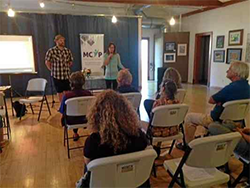
In the News
Youth Advocates Offer Tools for Addressing Childhood Trauma
-
Focus Areas
Chronic Disease Prevention, Women, Youth & Children -
Issues
Adverse Childhood Experiences, School-based Efforts -
Expertise
Research – Survey
 On Tuesday, September 6, Aurelie Clivas and Carter Grissom of the Mendocino County Youth Project spoke about the effects of trauma on the developing brains of young people. Their talk, at the Willits Center for the Arts, was part of the Howard Foundation’s Avenues to Wellness program.
On Tuesday, September 6, Aurelie Clivas and Carter Grissom of the Mendocino County Youth Project spoke about the effects of trauma on the developing brains of young people. Their talk, at the Willits Center for the Arts, was part of the Howard Foundation’s Avenues to Wellness program.
Grissom described his job as “program manager, counselor, hairstylist…I do it all,” as a short-term crisis counselor in Ukiah.
“Neither of us has a lot of letters behind our names,” remarked Clivas, a youth advocate in the Willits and Laytonville area; “but we meet kids where they’re at.” Being traumatized, she said, increases the production of cortisol, which is “like driving a car in overdrive all the time.” After a certain amount of extreme stress, she explained, the body gets used to being traumatized all the time and is poorly adapted to situations that appear to be stress-free to most people.
Being accustomed to stress, however, does not appear to result in a greater capacity to tolerate it. On the contrary, the over-stressed individual is more likely to collapse under the pressure of seeking approval; is more afraid to try and fail; and is especially sensitive to peer assessment.
These conclusions are based on an assessment tool called the Adverse Childhood Experiences (ACEs) test, developed by Dr. Robert Anda, an epidemiologist with the Centers for Disease Control and Prevention, and Dr. Vincent Felitti, of Kaiser Permanente’s Department of Preventive Medicine. In 1985, Felitti was running an obesity clinic in San Diego when he realized that many of his dangerously overweight patients had been sexually abused. He developed a questionnaire for the patients, but his findings were disregarded because of the small number of participants. Anda expanded the study to include 17,421 patients and a wider variety of abuse and dysfunction. Each of the ten questions on the test addresses a kind of trauma, so, for example, those who have been verbally abused, have a parent in prison, and lived with an alcoholic before the age of 18, have three ACEs, no matter the intensity or frequency of the trauma. Those with four or more ACEs are 12 times more likely to attempt suicide and have a 240 percent higher risk of hepatitis and sexually transmitted disease than their peers with a lower score.
According to a survey from the Public Health Institute in Sacramento, 50 percent of Mendocino County residents have at least two ACEs, compared to 40 percent statewide; 23 percent have four or more, compared to 17 percent in California as a whole. In a room of 31 people at the presentation Tuesday night, the average ACEs score was 4.8.
Originally published by Willits News
More Updates
Work With Us
You change the world. We do the rest. Explore fiscal sponsorship at PHI.
Support Us
Together, we can accelerate our response to public health’s most critical issues.
Find Employment
Begin your career at the Public Health Institute.



